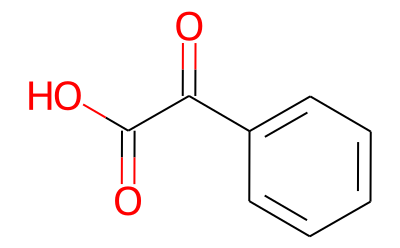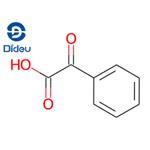Chemical Properties
white to light yellow adhering crystals,
Uses
Phenylglyoxylic acid can be used as a precursor in the synthesis of:
- O-acyl acetanilides by decarboxylative o-acylation of acetanilides using Pd catalyst.
- Phenylhydroxycarbene by high-vacuum flash pyrolysis.
- 2-arylbenzothiazoles by reacting with o-aminothiophenol using ammonium niobium oxalate (ANO) as a catalyst.
- 3-aryl-2H-benzo[b][1,4]benzoxazin-2-ones by treating with o-aminophenol in the presence of ammonium niobium oxalate catalyst.
- 2-aryl benzothiazoles through potassium persulfate (K2S2O8)-mediated oxidative condensation of benzothiazoles.
Uses
Phenylglyoxylic Acid (cas# 611-73-4) is a compound useful in organic synthesis.
Definition
ChEBI: A 2-oxo monocarboxylic acid that is glyoxylic acid in which the aldehyde hydrogen is substituted by a phenyl group.
Safety Profile
A poison by intravenous route. When heated to decomposition it emits acrid smoke and irritating vapors.
Synthesis
The synthesis of Benzoylformic acid is as follows:Acetophenone (120 g, 1 mol) was dissolved in 2000 ml of pyridine, and 165 g (1.5 mol) of selenium dioxide was added under stirring.The mixture was refluxed for 3 hours and left to cool overnight.Filter through celite, wash the filter cake with xylene, and combine the filtrate and washings with azeotropic evaporation.The evaporated residue was dissolved in 1 L of ethyl acetate and washed with 300 ml of 10% dilute hydrochloric acid.The organic layer was washed with 400 ml of 5% sodium hydroxide solution, and the washed aqueous layer was adjusted to pH 2-3 with 10% dilute hydrochloric acid.A white solid precipitates, is filtered, the filter cake is washed with water, and dried to obtain 120 g of a white solid.Yield: 87%, purity: 99.2%.

Purification Methods
If the sample is oily, then it may contain H2O. In this case dry it in a vacuum desiccator over P2O5 or KOH until crisp. For further purification dissolve 5.5g in hot CCl4 (750mL), add charcoal (2g, this is necessary otherwise the acid may separate as an oil), filter, cool in ice-water until crystallisation is complete. Filter the acid off, and the solvent on the crystals is removed by keeping the acid (4.5g) in a vacuum desiccator for 2 days. Slightly yellow crystals are obtained. It can be recrystallised also from *C6H6/pet ether, and can be distilled in a vacuum. The acid is estimated by titration with standard NaOH. The phenylhydrazone is recrystallised from EtOH, m 163-164o, and the semicarbazone acid has m 259o(dec) (from EtOH). The methyl ester distils at 137o/14mm, 110-111o/2mm, n 20 1.5850. [Baert & Kates J Am Chem Soc 67 1482 1945, Schaffer & Corey J Org Chem 24 1825 1959, Beilstein 10 H 654, 10 IV 2737.]





